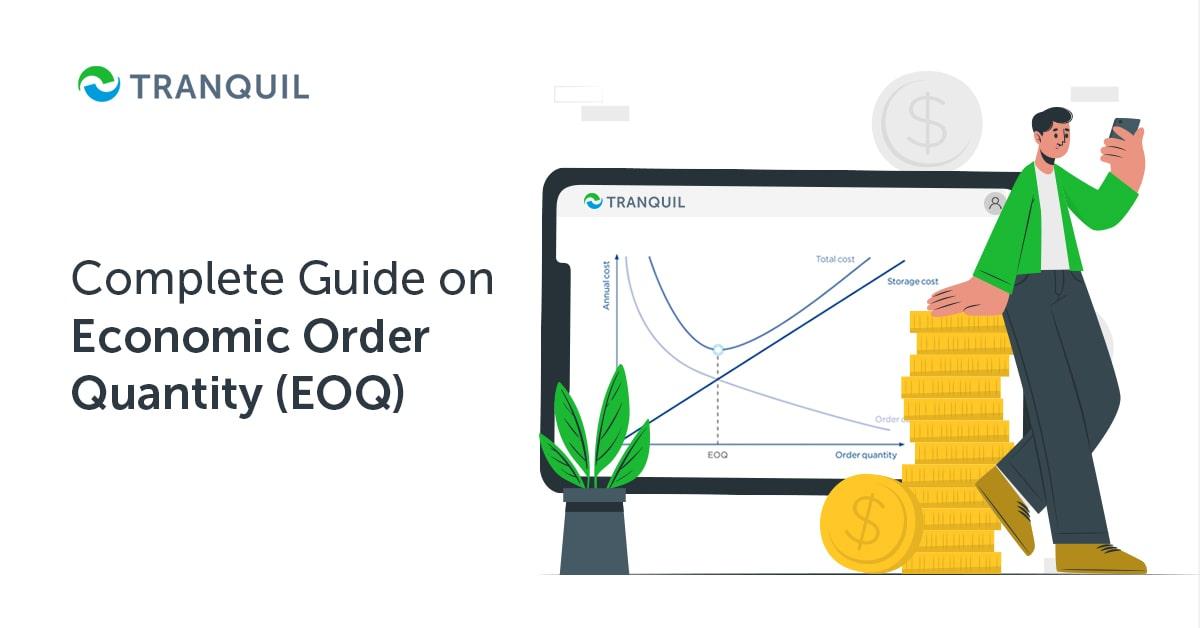
Knowing when to order products and how much to order, to replenish your stock, is a critical element of inventory management.
Unfortunately, many businesses do this without much forethought, and in a haphazard manner.
They place orders on guesswork rather than use a scientific approach.
This may not always be effective, as several external and internal factors can impact your need for those goods.
In other words, you may place an order for 100 units of a product, knowing that the demand is 25 units per week, and it takes 2 weeks to reach.
You plan to reorder when you have 50 units left.
But let us suppose that for some reason, the demand spikes up, and you sold 75 units in two weeks.
ALSO READ: Why is Cycle Stock Important for Your Business?
You place the order, but the product gets stocked out – you end up losing sales, as the customers who come later cannot find the product.
The opposite can also happen – you order too much, and you end up with excess or dead stock.
Therefore, instead of ordering what you think you need right now, it makes sense to use the Economic Order Quantity formula to order a specific inventory item.
This scientific approach will save you money and aid you in informed decision-making regarding reordering inventory items.
EOQ means economic order quantity.
It is a formula used by various departments like supply management, logistics, and operations.
Quintessentially, economic order quantity in inventory management is a tool that helps to establish the volume and frequency of orders needed to fulfil a specific level of demand, and at the same time, ensure minimal cost per order.
ALSO READ: What is Negative Inventory and How Can you Prevent it?

We have seen above that the EOQ helps to lower the cost per order, as well as inventory carrying costs.
When you have large volumes of orders, the per-order cost of ordering inventory reduces, thanks to economies of scale.
But then, when the inventory size increases, the inventory carrying costs also increase.
EOS is the point that balances and lowers both these costs which are inversely related.
EOQ is an important measurement that can showcase the sustainability of your organization, as ordering in excess can leave you with fewer finances for other business activities, apart from incurring high carrying costs.
Departments like R&D and marketing can help in lowering expenses and increasing revenues, but may not get sufficient funds if you have a lot tied up in inventory.
ALSO READ: Benefits of Blockchain in Cloud Computing
Inventory is part of your working capital; this is a capital that comprises business assets required to conduct operations regularly.
However, excessive working capital can hamper your profitability, and increase your opportunity cost.
EOQs are not required for things like office supplies, but for expensive, high-volume purchases.
When the volume of your orders and inventory stocks grows, EOQ will have a more significant impact on your profitability.
With accurate forecasting of inventory, your business can boost profits instead of having to deal with dead stock that can cause losses.
In short, this is the golden rule as far as inventory forecasting is concerned: the lesser the funds that are tied up in inventory, the more ideal is the level of inventory stock maintained, and the more precise the ordering.
ALSO READ: What is Demand Forecasting?
EOQ conveys to a company, the ideal ordering quantity for each product they stock.
The formula for EOQ however, makes an assumption that there is no variation in the demand for a product for the year.
However, if your business is growing and the demand keeps changing, then this method may not be the best one to calculate your optimal order size.
After calculating the economic order quantity, you will be able to know how many orders you ideally need to place in a year and the optimal size of the orders.
You can adapt the model to include defective items, backorders, discounts in pricing, and so on.
In fact, the answers provided by your economic order quantity calculator will let you have an ideal schedule of your supply chain order.
ALSO READ: Understanding the Importance of Distribution Management

The most important benefit of economic order quantity is increased profit.
Let us see what other benefits this tool provides, in some detail:
EOQ ensures that you have the requisite products with you when you need an inventory item for order fulfilment or manufacturing.
This means you can continue uninterrupted production or ship out the order in time, and keep your customer happy.
It translates further into enhanced customer experiences and better sales.
ALSO READ: Important ERP Implementation KPIs to Know
With proper forecasts, you will know what you need so that you don’t order too much and have funds overinvested in inventory.
With optimized order schedules, you can avoid obsolete or dead stock; this is especially important for companies dealing in perishable inventory or products likely to go out of vogue soon.
When your orders are aligned with your demand, you will have lesser inventory and thus lower inventory holding costs, like storage rentals, utility bills, insurance, security, labour, and more.
ALSO READ: Why Safety Stock is Important?
When you plan and the time your orders properly you can avail good discounts, as most suppliers offer discounts on bulk orders.
While EOQ is very beneficial for determining optimal order sizes, this method comes with its own challenges; it is not very easy to achieve.
Here are some of them:
This is one of the main challenges of EOQ calculation.
Often, businesses have manual systems or use simple spreadsheet-based systems.
These systems are unlikely to give you up-to-date and high-quality data; this can even cause improper calculations.
ALSO READ: What is ABC Analysis in Inventory Management?
Old systems are not likely to have complete and updated information, leading to several problems.
This can be solved by implementing an ERP solution like Tranquil.
The EOQ formula is great for businesses that have fairly consistent inventory requirements.
But a rapidly growing business cannot rely on this method, as it can cause a shortage in inventory and stocked out situations.
For companies selling products that have seasonal demands, EOQ, while not impossible, certainly becomes difficult.
The demand keeps changing throughout the year, and hence it does not make sense to have one single formula.
ALSO READ: What is UOM in Inventory?

After carefully considering what could be the factors affecting economic order quantity, a formula to calculate the same was devised.
The EOQ is calculated by reducing the total cost per order by defining the first-order derivative as zero.
The formula elements that comprise the total cost of each order are the expense of carrying that inventory and the expense of ordering the said inventory.
You need to remember these components and their abbreviations:
D – Quantity of Demand per year
Q – Quantity or Volume in each order
S – The fixed cost of ordering or Ordering Cost
C – Variable per unit cost
H – Variable holding cost
i – Interest rate or carrying cost
ALSO READ: What is Storage Cost of Inventory?
The number of orders that are placed each year can be derived by dividing the yearly demand by the volume in each order.
It is expressed as:
No. of orders = D/Q
For every order that has a fixed cost – regardless of the quantity or number of units, the yearly ordering cost or S is arrived at by multiplying this fixed cost by the number of orders.
Expressed as:
D/Q * S
ALSO READ: A Complete Guide to Cash Flow Analysis
Stocking inventory has a cost associated with it; this can be direct costs like the storage cost of the inventory, or indirect, like the opportunity cost of storing inventory rather than using those funds for purposes like marketing.
The per unit carrying cost is expressed as the per unit cost multiplied by the interest rate, like this:
H = iC
This of course, assumes that there is no variation in demand, and the stock in hand gets depleted at a steady rate.
When the inventory finishes or reaches a certain level, the company places orders for replenishing the inventory.
The inventory holding cost is arrived at by calculating the total inventory product at a given time and the carrying cost per unit. It is expressed as:
Q/2 *H
ALSO READ: Debit notes and Credit Notes
Adding the two costs tells us the total cost of orders for the year.
To find the ideal quantity that can be ordered to keep this cost at a minimum, the total annual expense is differentiated with regard to the element Q.
It is expressed thus:
Annual Total Cost (TC) = D/Q * S + Q/2 * H
EOQ Formula
EOQ = dTC/dQ = √2SD/H
ALSO READ: Why is Physical Stock Verification Necessary?

When you calculate the economic order quantity, you get the optimal order size that will help you get maximum profits for your business.
It eliminates the need for guesswork and helps you avoid situations like stockouts and excessive ordering.
You can leverage the data and figures to take improved, informed, and timely decisions about the inventory requirements of your organization.
Economic Order Quantity can have an especially significant effect on your business if you have a big business if you are incurring heavy inventory carrying costs, or if your inventory is very expensive in itself.
You can significantly enhance your operations to improve productivity and efficiency, cash flows, and profitability for the future.
Tranquil Cloud ERP has a robust inventory management module that can help you manage your inventory efficiently, and always maintain the optimal stock. This can help you cut expenses and boost profitability, and make sure that your financial and other resources are not unduly tied up in inventory. To see how our software works and how it can benefit your business, do schedule a demo at your convenience. We will be happy to give a detailed explanation and answer any queries you may have.